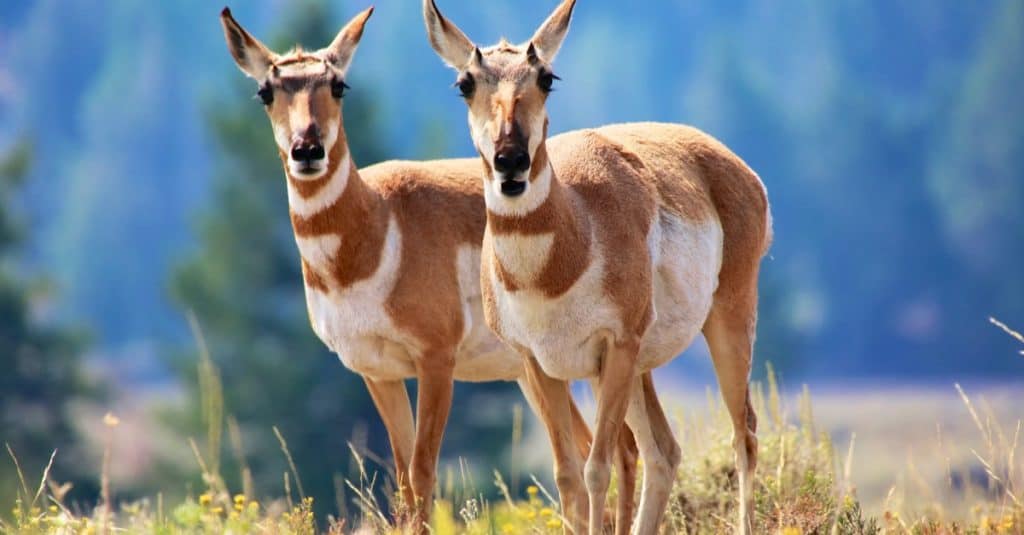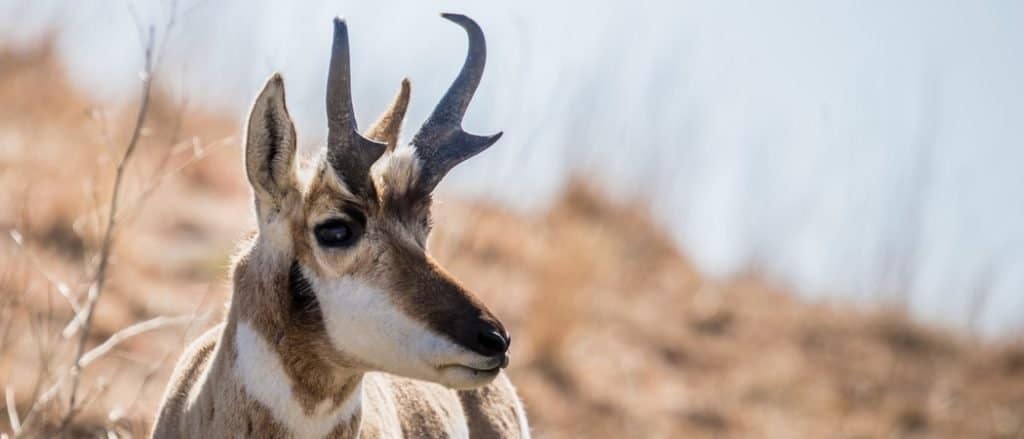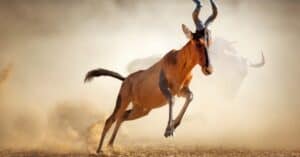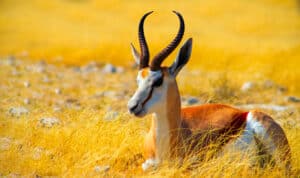If you hear the word “pronghorn,” you may wonder what it is. A pronghorn is actually a pronghorn antelope. They are popular game animals in different areas throughout the United States, particularly areas like Texas where there is a strong emphasis on hunting. Pronghorn hunting is very popular in the state. You might wonder, how big are the biggest pronghorns? Keep reading to learn all about the largest pronghorn caught in Texas!
Background Information on the Pronghorn

This interesting animal is not technically an
antelope
. It is actually the fastest-hoofed animal in North America, able to run a whopping 60 mph.
©matthieu Gallet/Shutterstock.com
The pronghorn is a very interesting animal in a variety of ways. Even though its full name is “pronghorn antelope,” it is not technically an antelope. It is actually the fastest-hoofed animal in North America, able to run a whopping 60 miles per hour. They are not quite as fast as cheetahs, but they have more endurance at a fast speed than cheetahs do.
Range
You will only find pronghorns in North America. Their natural range is Northern Mexico to Southern Canada. They are found in the largest numbers in the Great Plains, Montana, Wyoming, New Mexico, Arizona, Colorado, Utah, Nevada, Southeast Oregon, and Northeast California.
Habitat
Pronghorns tend to inhabit open areas. These include plains, grasslands, deserts, fields, brush areas, and basins. They migrate long distances prior to winter in order to survive harsh winter conditions. They have the longest land migration of any hoofed animal in the lower 48 states of the United States.
Pronghorn herds get bigger and smaller depending on what season it is. In the summer, females will simply gather with their young in herds of less than a dozen. The herds are much larger during the winter, including males and females and possibly hundreds of pronghorns in total.
Appearance
Pronghorns are about 2.5 to 3.25 feet tall at the shoulder. Large males can weigh up to 90 pounds, with females weighing a little bit less.
Pronghorns have body shapes similar to those of deer. They have long snouts, short tails, and long legs. They are usually reddish brown in color, although they can also be dark or brown or tan.
Pronghorns typically have white markings on their stomachs, faces, and backsides, as well as white stripes on their necks. The white hairs on the backside tend to stand on end when the animal is scared.
Both male and female pronghorns have horns. The horns of the males are longer (10 to 12 inches) and branch off at the end into two prongs. The longer prong curves to the back, while the shorter one curves forward.
Females typically only have small horns, in appearance only bumps. Pronghorns shed their horns every year after the mating season, growing them back during the winter.
Pronghorns also have large eyes. They have outstanding vision, which helps them spot predators from long distances.
Lifestyle
Pronghorns are the fastest animal in the Western Hemisphere. Their speed is crucial to their survival, as they live in open areas. They don’t have the ability to hide from predators. When they are running, they not only go up to 60 miles per hour but make bounds of up to 20 feet at a time!
These animals are active both during the day and night. When they sense a threat, they can attack with their sharp hooves. They can spot these threats up to four miles away because of their stellar vision.
Diet
Pronghorns are herbivores. In the summer, they tend to graze on prairie plants such as cacti, forbs, and grasses. In the winter, they will eat the plants that are available, such as sagebrush.
They also digest their food twice. The food goes through their stomach and is regurgitated. The regurgitated mass of food is referred to as cud. By digesting the cud, the animal is able to derive more nutrition from the material as it is broken down into smaller pieces. They do not drink a lot of water because they obtain the water they need from the plant material.
Predators
Pronghorns have many predators, including eagles, bears, cougars, wolves, and coyotes. They are usually able to escape them because they can spot them from very far away and run very fast.
Pronghorns in Texas

They occupy a massive area of about 14 million acres in the Edwards Plateau, Rolling Plains, High Plains, and Trans-Pecos Ecological Regions.
©Jen DeVos/Shutterstock.com
Pronghorns occupy multiple areas in the state of Texas. One of these areas is the Chihuahuan Desert, which is the second largest desert on the continent of North America.
They occupy a massive area of about 14 million acres in Texas in the Edwards Plateau, Rolling Plains, High Plains, and Trans-Pecos Ecological Regions. Approximately 70% of these animals occupy the Trans-Pecos region.
There is a well-known resident population of pronghorns just south of the city of Marfa, Texas. There is also a more mobile population between the cities of Fort Davis and Alpine. This population can often be seen grazing right alongside cattle.
Official Scoring System for Hunted Pronghorns
Boone & Crockett’s scoring system for pronghorns can be somewhat confusing to those who have a limited amount of hunting experience. These animals are not judged by height or weight but by a calculation involving various measurements along their horn.
The length of the horn, different circumferences along the length, and the length of the prong that hooks off of the horn are what determine the final score.
There needs to be a drying period of 60 days before judges can officially take measurements. Typically, the horns and prongs will shrink in that time. The minimum score required to receive an award is 80″.
The Largest Pronghorn Caught in Texas
The largest pronghorn caught in Texas received a score of 90-4/8″. The hunter was Walter O. Ford III, and he made the catch in 1994.
The Largest Pronghorn Ever Caught in the World
However, the largest pronghorn ever caught in Texas is not the largest ever caught. This record-breaking animal received a score of 96-4/8″ and was captured in New Mexico by Mike Gallo in 2013. Gallo has not only achieved the world record, but he is also the one who killed the top three scoring pronghorns in the state of New Mexico.
This massive pronghorn is currently on display in the Boone & Crockett National Collection.
Where is Texas Located on a Map?
Located in the South Central region of the United States, Texas is the second-largest state in terms of both area and population. With a land area of 268,596 square miles and a population exceeding 30 million in 2023, it is a significant and populous state.
Here is Texas on a map:
The photo featured at the top of this post is © BGSmith/Shutterstock.com
Thank you for reading! Have some feedback for us? Contact the AZ Animals editorial team.






